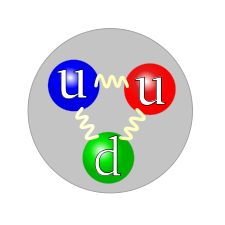Protons and neutrons are atoms
How much energy does it take to accelerate a particle to more than the speed of light? It all depepnd upon the mass of that particle, does it not? You must understand in your own mind the relationship between mass and velocity (the inverse square law), which makes it possibe for a photon to travel at the speed of light.
First we have to name that particle. It is not a lepton, a clingon, a quark or a quirk. In my theory these do not exist. They explain a theory which is simply inadequate to explain what is happening within a proton or a neutron, appologies to Mr Higgs.
This ia a particle which can travel at about 2 million light years a second. If it exists, ther will be particles of double it mass, and particles which can travel at half its speed, or a million light years a second. Without this particle there would be no intergalactic travel. How do we know there is intergalactic travel? We simply don't, but if we assume it is possible, we can look for evidence. Let us also assume that it is illegal for a being to leave its solar system or galaxy. Why, because it would distort progress and lead to disorder within the universe. If a being did visit our galaxy from another galaxy, let us assume it is a top order predator, from an advanced civilisation, and is some sort of intergalactic policeman and means us no harm. It is protecting us from unwanted visits from other aliens, and would have put means in place to prevent this long before the civilisation advanced far enough to make it possible. Such an alien would be exactly like the Roswell aliens, and America would know this is true, if it has a space vehicle, which I believe it has.
All this discourse is being reviewed (2014), so the outline of it is contained within the first ten pages which are not yet compleete.(14-11-2014).
Notes, up for revision, do not read. They do not make sense for you yet.
The first thing is that if one of the things within the nucleus is exactly the same as a Hydrogen atom, compressed down to a fraction of its size, but with the same energy.
Then the other two things have (according to my theory) at least equal mass (Energy), and probably more. If one of the (other) things is exactly the same (in shape and logical structure) as a Helium atom, with one "positive charge" and one "neutral or balanced charge.
It will have more than twice the mass of its positively charged sister particle, (as a Hydrogen atom has).
The third thing is another atom, and is different from the other two, the next logical (simplist) shape is that of a Lithium atom, with three particles in the nucleus, one positively charged, like a proton
The energy required will therefore be in the range of (3 x 10) 5 . This is assuming that the fifth level (down) is the first level (within a Hydrogen atom, or nucleus) at which particles, no longer photons, can be accellerated by a collision to a velocity faster than the speed of light.
The point is that although these particles propogate perpendicular to the collision, stay within the atom, or rather transfer to a nearby atom, but do not emerge as photons, which can only travel at the speed of light.

A proton, composed of two up quarks and one down quark. (The color assignment of individual quarks is not important, only that all three colors are present.)
| Type | First | Second | Third |
|---|---|---|---|
| Quarks | |||
| up-type | up | charm | top |
| down-type | down | strange | bottom |
| Leptons | |||
| charged | electron | muon | tau |
| neutral | electron neutrino | muon neutrino | tau neutrino |
In particle physics, a generation (or family) is a division of the elementary particles. Between generations, particles differ by their (flavour) quantum number and mass, but their interactions are identical.
There are three generations according to the Standard Model of particle physics. Each generation is divided into two leptons and two quarks. The two leptons may be classified into one with electric charge −1 (electron-like) and one neutral (neutrino); the two quarks may be classified into one with charge −1⁄3 (down-type) and one with charge +2⁄3 (up-type).